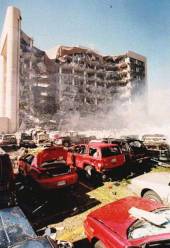Strangely, many in the 9/11 Truth movement (including ourselves) have remained under-informed on the specifics of the Oklahoma City tragedy and the very legitimate doubts concerning the official story. We will continue to update this page as we learn more.
Evidence
There have been compelling arguments that the ammonium nitrate (fertilizer) truck bomb, supposedly used by McVeigh, could never have caused the extent of damage that occurred. Essentially, a large chunk of the building was completely demolished, and this result is said to be impossible with a bomb of this size and type, exploded at some distance from the actual structure.
An expert in explosives, Brigadier General Benton K. Partin, USAF (Ret.) submitted a report to the US congress detailing the case for secondary explosives. 7
Mainstream news reports from the day of the bombing repeatedly and extensively speak of “secondary devices,” other explosives—some undetonated—found within the building. See videos.
Reportedly, no badge-carrying federal agents (ATF, etc.) were in the building at the time of the blast. There are reports that some such agents were warned not to come to work that day.
“In 2006, congressman Dana Rohrabacher said that the Subcommittee on Oversight and Investigations of the U.S. House Committee on International Relations, which he chairs, would investigate whether the Oklahoma City bombers had assistance from foreign sources.” 5
Witnesses saw McVeigh in the company of middle eastern men, including on the morning of the bombing, in the Ryder truck. 8
Oklahoma City police officer, Terrance Yeakey, was a heroic first responder at the scene of the bombing. Apparently, he saw some things that he wasn’t supposed to see. He called his wife that morning saying, “It’s not true. It’s not what they are saying. It didn’t happen that way.” Over the next year, Yeakey was compelled to begin his own investigation into the bombing. Yeakey told friends he had important information that showed the government’s story to be a lie, and that he was being intimidated and tailed by federal agents. In May 1996, three days before he was scheduled to receive the Medal of Valor from the OKCPD, he was brutally murdered. Despite the fact that his injuries included eleven slashes to both forearms, two cuts to his throat, what appeared to be rope burns and handcuff marks, and a final shot to the head, and the fact that he was found more than a mile away from his car, his death was quietly ruled a suicide after the OKCPD and FBI took over the case. 11
